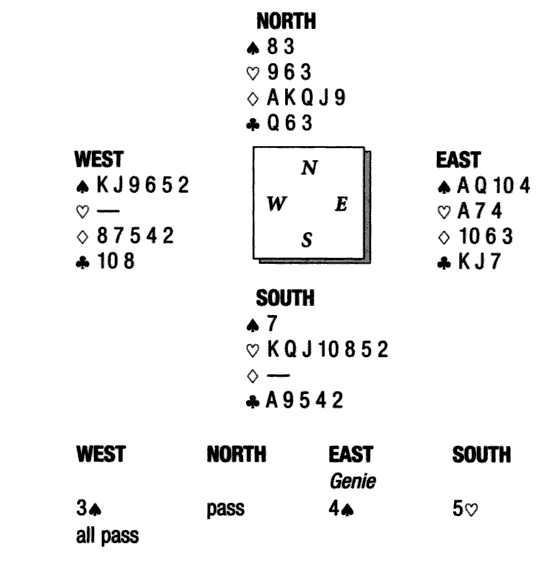 Source: Around the World in 80 Hands By Zia Mahmood, David Burn
Source: Around the World in 80 Hands By Zia Mahmood, David Burn
Three young bridge experts were walking along a beach the day before a major tournament when they came across a strangely-shaped bottle. As one of them picked it up and rubbed it with his sleeve, a genie flew out.
«My name: said this apparition, «is Zi Ham Chag — Master Genie of Bridge. I can grant you any wish you desire. If you are not satisfied with my gift, I will be forced to return to the bottle for another thousand years — but if you are, I will be free at last!»
Being typical bridge players, the three were more concerned about a fourth for a practice session than anything else. And if this genie were truly a master of the game, who knew what they might learn. Seated by the water’s edge this hand was dealt:

West led the ![]() 2 against five hearts, and dummy followed with the
2 against five hearts, and dummy followed with the ![]() 3. The genie, after considerable thought, played the
3. The genie, after considerable thought, played the ![]() 4!
4!
As South won with the ![]() 7, West leapt to his feet. «That’s enough this genie is obviously an impostor!» he cried. South and North readily agreed, as it was obvious that anyone who allowed declarer to win so cheap a trick could not possibly be a Master Genie. Stuffing the protesting genie back into the bottle, they hurled it into the sea and continued with their promenade.
7, West leapt to his feet. «That’s enough this genie is obviously an impostor!» he cried. South and North readily agreed, as it was obvious that anyone who allowed declarer to win so cheap a trick could not possibly be a Master Genie. Stuffing the protesting genie back into the bottle, they hurled it into the sea and continued with their promenade.

Later that evening, they showed the hand to the great analyst Michael Rosenberg, expecting him to chuckle with them over the genie’s preposterous play. To their surprise, he studied the hand gravely for several minutes without saying a word. Finally, with tears in his eyes, he spoke: «You have committed an unforgivable wrong. The problem on this hand is that South has plenty of tricks — but he cannot reach dummy unless the defenders allow him to do so. Thus, he will on the face of it lose a spade, a heart and two clubs. But if East makes the normal play of winning the first spade and returning the suit (any switch allows declarer to reach dummy’s winning diamonds), then South will ruff with the ![]() 10 and lead the
10 and lead the ![]() 8 to dummy’s nine. East must win with the
8 to dummy’s nine. East must win with the ![]() A — but this time, any card he returns will allow declarer an entry to dummy, and the losing clubs will all dis-appear on the solid diamond suit. Not at once, of course, for East can ruff the fourth round of diamonds — but South can overruff and return to dummy by playing the
A — but this time, any card he returns will allow declarer an entry to dummy, and the losing clubs will all dis-appear on the solid diamond suit. Not at once, of course, for East can ruff the fourth round of diamonds — but South can overruff and return to dummy by playing the ![]() 2 to the
2 to the ![]() 3 in order to cash the fifth diamond.
3 in order to cash the fifth diamond.
«But, amazingly, by allowing declarer to win the first spade with the seven in his hand, East avoids the throw-in. If South plays the ![]() 8 to the nine, East simply exits with the
8 to the nine, East simply exits with the ![]() 10. South cannot discard on this, for West will overtake and play a club, and if South ruffs the
10. South cannot discard on this, for West will overtake and play a club, and if South ruffs the ![]() 10 he can never reach dummy and must lose two club tricks at the finish.
10 he can never reach dummy and must lose two club tricks at the finish.
«Of course continued Rosenberg, «South ought to have played the ![]() 8 from the table at Trick 1. East cannot permit this card to hold, otherwise South can run the diamonds at once, and when he covers the
8 from the table at Trick 1. East cannot permit this card to hold, otherwise South can run the diamonds at once, and when he covers the ![]() 8 South can play as I described earlier.
8 South can play as I described earlier.
«But when declarer committed the obvious blunder of playing low from dummy to the first trick, your genie found the most wonderful defense ever seen in the history of the game. And you idiots threw him back in the sea!»
(The hand above is shamelessly stolen from Geza Ottlik and Hugh Kelsey’s wonderful book, Adventures in Card Play. If you found it difficult to follow, I’m sorry — but it is so beautiful that I could not resist using it.)
